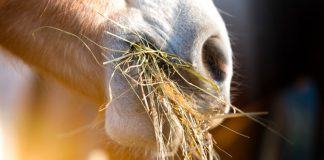
Q: My 8-year-old Quarter Horse is on high-quality grain and a regular deworming program, but he’s just not filling out in the hip area. He’s at a good weight otherwise, possibly even a bit overweight. He’s started regular training and is about to be broke to saddle. Is there anything I can do to get him to fill out?
A: You pose an interesting question, however without seeing a picture of your horse, I’m not positive that you and I are on the same page. One way that veterinarians, nutritionists, and other horse health care professionals can ensure they’re talking apples to apples with owners is by utilizing the Henneke Body Condition Scoring Scale.
Developed at Texas A & M University in the 80s, the BCS scale provides a standardized scoring system that takes into account the amount of fat cover a horse has in certain parts of his body:
1 = emaciated
2 = very thin
3 = thin
4 = moderately thin
5 = ideal or moderate
6 = moderately fleshy
7 = fleshy
8 = very fleshy (fat)
9 = very fat (obese)
There are six areas on the horse’s body where the degree of body fat is assessed. These are 1) the neck, 2) the area behind the shoulder, 3) the withers, 4) the ribs, 5) the loin, and 6) the tailhead. When evaluating the level of fat in each of these locations it is important to feel its thickness with your hands as well as visualize it because looks can be deceiving!
Some disciplines (e.g. racing) and some life stages (e.g. pregnancy) prefer a lower or higher BCS than the ideal or moderate “5.” Also, some extremes in conformation (such as very high withers or a swayback) can make evaluating the degree of fat cover for a certain area challenging. In some cases, you may have to throw out one or two of the six scores before averaging the rest to come up with a single numerical value. And because some horses didn’t read the book, it’s okay to record an in-between score like 4.5 or 6.5 using half points.
So I suggest you officially body condition score your horse to establish some baseline values that will help determine if your horse is at a good weight (5) or overweight (6 and above). At the same time, have your veterinarian perform a complete physical examination on him to make sure there are no underlying medical reasons for the problem you describe. This would also be a good time to pick your vet’s brain about why your horse is overweight (if he is) but lacking hip muscle development (if that’s the issue).
Once everyone is on the same page, a plan can be developed to address the problem, which may incorporate medical treatment, feed changes, training approaches, or some other solution, depending on what the primary issue is determined to be. However, your horse may just need to be in regular work to “fill out” so I suspect you may observe a positive difference once his under saddle career begins!
Throughout 2014, Dr. Lydia Gray will be answering your horse-health questions at HorseChannel.com/AskTheVet. Got a question for Dr. Gray? Send it to hc-editor@i5publishing.comand use subject line “Ask the Vet.”






